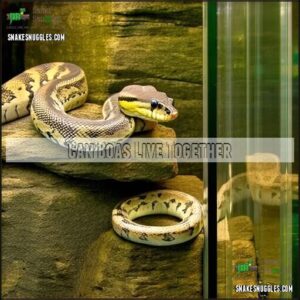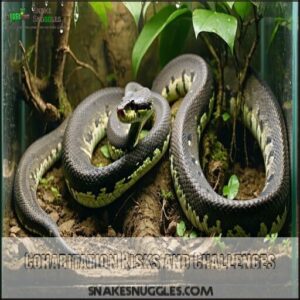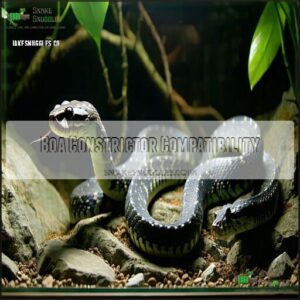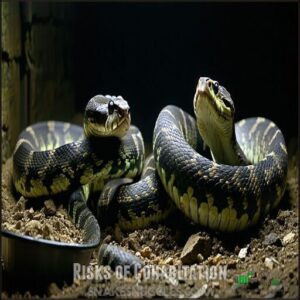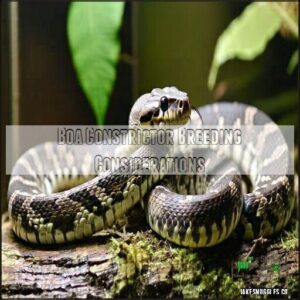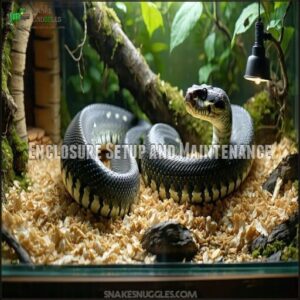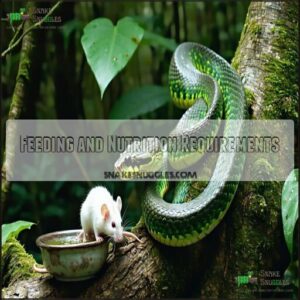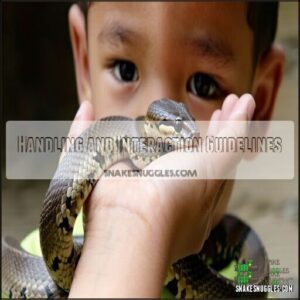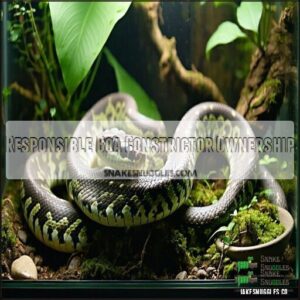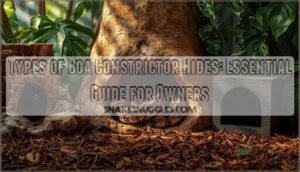This site is supported by our readers. We may earn a commission, at no cost to you, if you purchase through links.

These snakes are solitary by nature, and keeping them in the same enclosure can lead to stress, aggression, or even injury—kind of like roommates who just don’t get along.
Sharing space also makes it harder to monitor their health since you won’t always know who’s eating or shedding properly.
If you’re determined to house them together, you’ll need a massive enclosure, careful temperature and humidity control, and snakes of similar size and temperament.
However, separate housing is generally safer and healthier.
Curious about proper setups? Let’s explore further!
Table Of Contents
- Key Takeaways
- Boa Constrictor Social Behavior
- Can Boas Live Together
- Housing Multiple Boas
- Cohabitation Risks and Challenges
- Boa Constrictor Compatibility
- Benefits of Separate Housing
- Risks of Cohabitation
- Boa Constrictor Breeding Considerations
- Housing and Care Requirements
- Responsible Boa Constrictor Ownership
- Frequently Asked Questions (FAQs)
- Do boa constrictors mate?
- Do boa constrictors have health problems?
- Are boa constrictors a snake?
- How do boa constrictors survive?
- Are boa constrictors good pets?
- Are boa constrictors cold blooded?
- Can you keep two boa constrictors together?
- Do boa constrictors live in groups?
- How do boa constrictors handle shared feeding times?
- Do boa constrictors bond with their keepers?
- Conclusion
Key Takeaways
- Boa constrictors are solitary by nature and keeping them together increases risks of stress, aggression, and injuries.
- Sharing an enclosure makes it harder to monitor their health, as you won’t know which snake is eating, shedding, or showing signs of illness.
- If you’re set on housing multiple boas, you’ll need a large enclosure, proper temperature and humidity, and snakes of similar size and temperament.
- Separate housing is safer and healthier, reducing stress, preventing competition, and making care and monitoring easier.
Boa Constrictor Social Behavior
You might think boa constrictors enjoy company, but these snakes are naturally solitary and prefer being on their own.
Their territorial nature makes cohabitation risky, especially if sizes or temperaments don’t match.
Solitary Animals
Why do boa constrictors prefer being alone? Their solitary nature is key to survival, reducing stress and aggression from competition.
They thrive on their own, meeting their individual needs with minimal interaction.
- Natural Behavior: Boas are solitary in the wild, not social with others.
- Solitary Benefits: Less stress and aggression arise.
- Individual Needs: Each boa thrives independently.
Territorial Nature
Regarding snake territoriality, boa constrictors don’t like sharing space.
Resource guarding often leads to dominance displays and stress indicators, especially in limited enclosures.
Snake temperament varies, but solitary confinement suits their nature best.
Space competition increases snake aggression, making cohabitation risky, and boas prefer their own territory, so stressing them over shared areas is a bad idea.
Size and Age Similarity
When housing boa constrictors, size and age similarity are essential.
A size discrepancy can lead to resource competition, such as food or space, and may even trigger predatory behavior.
Younger boas grow at different rates, which can upset the age hierarchy in shared enclosures.
Snake cohabitation often results in snake aggression, making separate housing the safest option for their well-being.
Can Boas Live Together
Boa constrictors prefer the solo life, and keeping boas together isn’t usually a great idea.
These snakes are territorial, making communal boa constrictors a potential recipe for problems. Housing multiple snakes brings space competition, as every boa requires room to feel secure.
Feeding challenges pop up too; one boa may try to snatch food from another, which increases injury risks. Snake behavior hinges on individual boa constrictor temperament, so temperament matching becomes tricky—and mistakes can lead to stress or aggression.
Breeding concerns add more complications, as unexpected pairings often result in overbreeding. As with ball pythons, disease transmission risks increase with cohabitation.
Snake cohabitation is tempting, but their solitary nature and unique quirks make individual setups the safer option.
Housing Multiple Boas
When housing multiple boas, you’ll need to make certain their enclosure is spacious, secure, and well-maintained to prevent stress and competition.
Improper setups can lead to serious risks like disease spread, aggression, or even one snake viewing the other as prey.
Enclosure Size Requirements
A snake enclosure should prioritize space for growth and activity.
For a boa constrictor enclosure, minimum dimensions combine length and width matching the snake’s length.
Include vertical space for climbing, hiding spaces for comfort, and enrichment needs to reduce stress.
Growth considerations matter; larger boas require proper housing requirements to avoid overcrowding.
Always guarantee resource availability meets their health and safety, and prioritize space for growth to ensure the well-being of the boa constrictor.
Temperature and Humidity Control
For a healthy boa constrictor enclosure, keeping humidity and temperature control spot-on is vital.
Aim for:
- Basking area: 90-95°F with heat lamps or pads.
- Cool side: 75-80°F for temperature variations.
- Humidity: Maintain 60-75% using misting, foggers, or a water dish.
Use digital thermometers and hygrometers to monitor closely—snakes thrive when conditions mimic nature.
A reliable digital hygrometer guarantees precise measurements.
Substrate and Lighting Options
Creating the right enclosure design means considering substrate types and proper lighting spectrum.
A good boa constrictor substrate, like coconut husk or cypress mulch, balances humidity control and mold resistance. For various options, consider boa-safe substrates available online.
Avoid shallow layers—deeper substrate promotes natural burrowing.
When managing boa constrictor humidity and temperature, use heat gradients and maintain 12-hour lighting cycles to mimic their tropical origins.
Simple tweaks, happy snakes!
Risk of Disease Transmission
Even with great lighting and substrate care, housing multiple snakes raises health concerns.
Shared spaces allow parasites, fungal outbreaks, or bacterial infections to hop from one snake to another like bad gossip.
Avoid snake health risks by remembering these basics:
- Practice strict quarantine.
- Watch for signs of viral transmission.
- Keep enclosures spotless.
- Prioritize their health over convenience, which is crucial for preventing the spread of diseases and ensuring the snakes’ well-being, and always remember to quarantine.
Cohabitation Risks and Challenges
When you house boa constrictors together, you’re opening the door to potential aggression, stress, and serious injuries.
Identifying health issues becomes much harder in a shared enclosure, which can lead to delayed treatment and greater risks for all snakes involved, due to increased stress.
Aggression and Stress
Sharing a space can stir trouble for boa constrictors.
Stress indicators like hissing or defensive postures often point to resource competition or dominance behavior.
Handling stress worsens if one boa asserts control or shows aggression, and temperament impacts vary, but cohabitation injuries—like bites—are common.
Watch for incompatibility signs, as stressed snakes might lash out or grow defensive, creating a tense environment.
Difficulty in Identifying Health Issues
Spotting subtle symptoms in cohabitated boa constrictors is tricky.
Stress indicators, like reduced appetite or inactivity, often go unnoticed. Without early detection, minor health issues can escalate.
Quarantine importance can’t be overstated; it avoids spreading diseases. Even with veterinary expertise, health considerations in shared enclosures grow complicated.
Preventative measures simplify care, ensuring incompatibility signs don’t lead to bigger challenges for your boas, and highlighting the need for early detection and understanding of stress indicators.
Boa Constrictor Compatibility
Regarding boa constrictor compatibility, housing two of these solitary snakes together isn’t as simple as it sounds.
You’ll need to take into account factors like sex, size, and temperament, as even calm boas can get territorial under the wrong conditions.
Male and Female Pairing
Pairing boas for breeding requires careful planning.
Males and females are introduced only during breeding, limiting impact on female health from overbreeding. Pay attention to breeding frequency, as constant mating stresses females, affecting offspring care.
Ethical concerns arise when unplanned breeding floods the hobby. Guarantee genetic diversity and monitor snake breeding pairs to reduce risks and maintain healthy conditions. Constant mating stresses females, affecting offspring care, and it is crucial to address this issue to ensure the well-being of the snakes.
Individual Temperament Assessment
When considering boa compatibility, individual temperament matters.
Observe boa constrictor behavior closely—docile boas are better candidates than those showing aggression signs.
Watch for stress indicators like erratic movements.
Snake compatibility depends on behavioral observation, so try compatibility testing by safely handling each.
Aggression assessment during introductions guarantees safer outcomes, putting their unique personalities front and center, which is crucial for safer outcomes and understanding boa constrictor behavior.
Benefits of Separate Housing
Keeping boas in separate enclosures helps reduce stress and aggression, creating a more peaceful environment.
It also allows you to monitor their health more easily, ensuring each snake thrives without competition.
Reduced Stress and Aggression
Why push your luck? Housing boas separately promotes a calm environment, minimizing stress signs and aggression.
Solitary benefits include better stress reduction, as they thrive alone in nature. By focusing on space optimization and enrichment activities like diverse hiding spots, you mimic their wild habits.
Environmental enrichment also keeps them content without temperament matching hassles, ensuring handling techniques work smoothly, which is a key aspect of their wild habits.
Easier Health Monitoring
Health monitoring becomes simpler with separate housing.
You can focus on individual observation, noticing any changes in snake behavior or health quickly. Quarantine effectiveness improves for new additions, reducing disease risks.
Here’s how:
- Track snake wellbeing with accurate records.
- Spot symptoms like reduced appetite early.
- Minimize snake stress during care.
- Confirm effective snake monitoring daily.
By following these steps, you can ensure the health and wellbeing of your snakes, making it easier to identify any issues promptly.
Improved Overall Well-being
Separating your boas gives each snake a calm environment where natural behaviors thrive.
It reduces stress, prevents competition, and allows better environmental control.
Enrichment activities, like hiding spaces, support snake wellbeing without interference.
Individual housing also aids in health monitoring, making it easier to detect issues early.
Stress reduction benefits snakes, ensuring they live relaxed, healthy lives in their unique habitats.
Risks of Cohabitation
Housing boa constrictors together increases the risk of serious issues like cannibalism, disease spread, and injury from competition or aggression.
Cohabitation risks stress, aggression, and even cannibalism—boa constrictors thrive best when housed alone in secure environments.
Even with careful planning, the stress of shared space can harm their health and well-being.
Cannibalism and Injury
Cannibalism and injury are real risks when housing boas together.
Size discrepancies and snake territorial disputes can lead to conflicts, including bite wounds or worse. To avoid snake injuries, watch for stress indicators like aggressive postures.
Here are key risks:
- Snake aggression factors rise with resource competition.
- Feeding frenzies increase injuries.
- Cannibalism risk grows with mismatched sizes.
- Stress leads to fights.
- Injury prevention demands separate housing.
The main issue with housing boas together is that it can lead to conflicts, including bite wounds or worse, and even cannibalism.
Disease Transmission and Outbreaks
Snake disease transference is a ticking time bomb when boas share enclosures.
Parasites and infections spread quickly, pushing outbreak prevention to the forefront.
Quarantine protocols are your best friend—skip them, and identifying symptoms becomes tricky.
A reptile veterinarian can help, but shared space means faster contamination, so protect snake health by avoiding cohabitation; it’s better safe than sorry!
Overbreeding and Female Stress
Female boas housed with males year-round face snake breeding stress and snake breeding risks, including health impacts from constant pairing.
Overbreeding increases snake overpopulation and harms female recovery. Ethical breeding guarantees balanced genetic diversity and clutch health.
Here’s how you can prevent issues:
- Limit breeding frequency.
- Offer adequate female rest.
- Monitor snake breeding health.
- Avoid mixed-sex cohabitation.
- Seek veterinary support to ensure healthy recovery.
Boa Constrictor Breeding Considerations
If you’re planning to breed boa constrictors, timing and preparation are everything to guarantee a successful and safe process.
Proper quarantine, careful monitoring, and a close eye on the female’s health can prevent stress and potential complications.
Mating and Breeding Season
Boa constrictors should only meet during the snake breeding season, when certain environmental changes act as breeding triggers.
Males compete for females, and successful snake mating leads to a gestation period of 100-150 days.
Clutch size can vary, with live births requiring neonate care. Consider snake breeding risks, like birthing complications, and remember the advantages don’t always outweigh the challenges.
Female Health and Overbreeding
In the context of boa constrictor breeding, it’s important to balance frequency with reproductive health.
Overbreeding stresses females and reduces neonate viability, potentially leading to smaller clutch sizes or infertile eggs.
Ethical breeding prioritizes the snake’s well-being, ensuring proper recovery times between litters.
By managing snake breeding wisely, you reduce health risks and safeguard both mother and offspring.
Proper Quarantine Procedures
How do you keep your boa healthy when introducing new snakes? Start with a solid isolation setup.
A snake quarantine should last 30–90 days, ensuring time to monitor symptoms.
Include a vet examination and preventative treatment for parasites.
Proper boa constrictor care in their isolation period protects all your snakes.
Remember, diligent snake care prevents outbreaks and promotes lasting health.
It’s also important to follow strict disinfection protocols during this time, ensuring a healthy environment.
Housing and Care Requirements
To keep your boa healthy and comfortable, you’ll need an enclosure that mimics its natural environment with proper space, temperature, and humidity levels.
Regular maintenance like cleaning and providing fresh water is essential, but it’s not as challenging as it sounds, and includes tasks that are crucial for the boa’s well-being, such as regular maintenance.
Enclosure Setup and Maintenance
A well-thought-out enclosure setup guarantees your boa feels safe and healthy.
Snake enclosures should match your snake’s size, with hiding spots and proper heating options.
Maintain humidity control at 60-70%, and use substrates like aspen shavings.
Consider appropriate habitat dimensions for your boa’s health.
Stick to a cleaning schedule, spot-cleaning regularly and replacing the substrate monthly.
A cozy, clean snake habitat makes all the difference!
Feeding and Nutrition Requirements
A healthy boa constrictor diet requires properly sized prey, a balance in feeding frequency, and careful supplementation.
Follow these tips:
- Verify prey size doesn’t exceed 10% of your snake’s body weight.
- Feed juveniles every 10-14 days and adults every 3-4 weeks.
- Add calcium or D3 supplements sparingly for growth.
Consistent hydration methods help prevent obesity and maintain well-being.
Selecting the appropriate prey size is vital for boa health.
Handling and Interaction Guidelines
Handling a boa constrictor safely means respecting its space and mood.
Stick to short handling sessions, around 15 minutes, to avoid stress. Watch for signs like hissing or tightening coils—these mean the snake’s uncomfortable.
Regular interaction helps boas stay calm, but they don’t crave attention.
Teach kids snake safety, ensuring boundaries are clear. Remember, territoriality still applies—even during handling, and always be aware of the snake’s mood.
Responsible Boa Constrictor Ownership
Owning a boa constrictor means understanding its unique needs and planning for decades of care.
You’ll want to research thoroughly, as these solitary reptiles thrive best with careful attention to housing, health, and safety.
Research and Preparation
Before getting a boa constrictor, plunge into species identification to verify it’s the right fit.
Research enclosure planning for proper reptile care, including temperaments and compatibility signs.
Don’t skip legal considerations or finding veterinary access nearby.
If cohabitation crosses your mind, have a backup plan.
Safety precautions, like escape-proof enclosures, are vital.
Preparation now saves headaches later!
Long-term Commitment and Care
Caring for a boa constrictor means taking on decades of responsibility. With lifespans reaching 30+ years, their long-term care isn’t a sprint—it’s a marathon.
A boa constrictor is a lifelong commitment; their care is a marathon, not a sprint.
Factor in financial burdens, space requirements, and ethical considerations of housing these reptiles. Boa constrictor laws vary by location.
While boa constrictor cohabitation seems intriguing, snake risks vs rewards lean heavily toward individual housing for their health and your peace of mind.
Potential Risks and Challenges
Owning boa constrictors means understanding potential risks and challenges.
Housing them together can lead to snake aggression, territorial disputes, or even cannibalism risks.
Watch for stress indicators like hiding or skipped meals.
Disease outbreaks spread quickly in shared spaces, and feeding competition may trigger potential aggression.
Overbreeding harm is common with males pestering females excessively—avoid these challenges by keeping boas separate to prevent cannibalism risks.
Frequently Asked Questions (FAQs)
Do boa constrictors mate?
Boa constrictors mate to reproduce, with females sometimes producing up to 60 offspring in one clutch.
While mating behavior is fascinating to observe, you should only introduce males and females to breed intentionally, not casually, and consider the complete concepts of responsible breeding practices.
Do boa constrictors have health problems?
Boa constrictors can face issues like respiratory infections, mites, and digestive problems if their environment isn’t right.
Stress, poor nutrition, or unsanitary conditions can cause health problems, so regular checkups and proper care are essential.
Are boa constrictors a snake?
With some reaching lengths of 13 feet, boa constrictors are indeed snakes.
They’re non-venomous, kill prey by constriction, and thrive in the Americas’ tropical climates.
Their calm demeanor makes them fascinating but powerful reptiles to handle.
How do boa constrictors survive?
They survive by ambushing prey using camouflage and heat-sensing pits to detect warmth.
They constrict their meals, consuming them whole.
Adaptability to various habitats, plus their slow metabolism, helps them thrive even in tough conditions.
Are boa constrictors good pets?
Bringing a boa constrictor into your life is like inviting a quiet roommate.
They’re low-maintenance, calm, and fascinating.
With proper care, they thrive, but their size and needs require serious commitment and space considerations.
Are boa constrictors cold blooded?
Yes, boa constrictors are cold-blooded!
Like all reptiles, they rely on external heat sources to regulate their body temperature.
Without warm environments, they can’t function properly—think of them as solar-powered creatures.
Can you keep two boa constrictors together?
Keeping two boa constrictors together isn’t a great idea.
These snakes are solitary by nature and cohabitation risks stress, aggression, or even injury.
If you’re considering it, make certain of ample space, resources, and constant monitoring.
Do boa constrictors live in groups?
Boa constrictors prefer flying solo, sticking to their own space rather than living in groups.
These solitary snakes thrive best alone in the wild and in captivity, reducing risks of stress, aggression, or resource competition.
How do boa constrictors handle shared feeding times?
Too many cooks in the kitchen spoil the broth, especially during boa feeding.
These solitary snakes may compete aggressively over food, leading to stress or injury.
Feeding them separately guarantees safety and prevents unnecessary squabbles.
Do boa constrictors bond with their keepers?
Boa constrictors don’t bond with you like a dog might.
They recognize you mainly as a source of warmth and food, but their curiosity during handling can feel like a subtle connection.
Conclusion
Picture a tranquil enclosure that nurtures your snake’s well-being—this is easiest when boa constrictors live alone.
While cohabitation is possible, their solitary nature means it’s rarely ideal.
Sharing space can lead to stress, injuries, and trouble tracking health. If you’re determined, you’ll need a large enclosure, careful monitoring, and similar-sized boas with calm temperaments.
However, separate housing reduces risks, improves health oversight, and respects their natural instincts. When in doubt, keep them apart for peace and safety.


